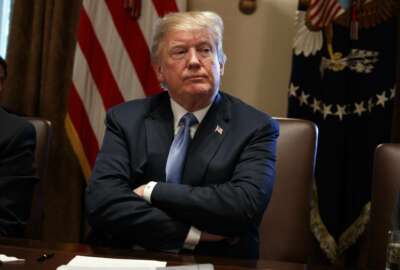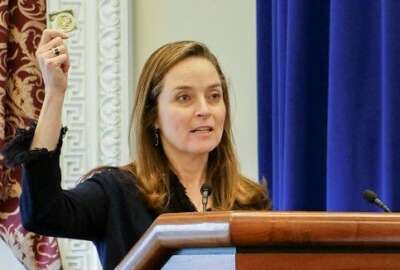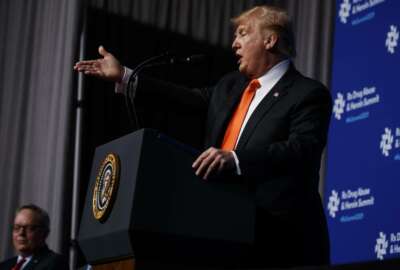
Trump administration takes another baby step to advance OPM-GSA merger
The Trump administration is taking another small step to shift functions at the Office of Personnel Management to the General Services Administration.
The Trump administration will soon take a few additional, small steps to advance its proposed merger of the Office of Personnel Management with the General Services Administration — and shore up OPM’s shaky financial standing ahead of the upcoming fiscal deadline.
The administration recently informed Congress of its plans to move the administrative support functions for two OPM-led councils, the Chief Human Capital Officers Council and the Performance Accountability Council, to GSA, Margaret Weichert, acting OPM director and deputy director for management at the Office of Management and Budget, told reporters Tuesday afternoon.
It’s a relatively small change, as GSA already supports several governmentwide executive councils and organizations, such as the Chief Information Officers Council and the Chief Financial Officers Council.
The leadership of these organizations isn’t immediately changing either.
The CHCO Council executive director, for example, will continue to drive the agenda for the organization as an OPM employee. The membership of the Performance Accountability Council, which includes the Director of National Intelligence, the OPM and OMB directors, and OMB’s deputy director for management, will also stay the same.
Weichert, in her dual-hatted position, currently holds two of those positions on the PAC. The PAC itself sets suitability and security clearance standards for the federal government. The administration said it didn’t envision the actual membership of the PAC would change, unless OPM loses its role as the suitability and credentialing executive agent through the upcoming reorganization and GSA merger.
Still, the plan to move support for the CHCO Council and PAC is another attempt to accomplish the goals of the OPM-GSA merger without Congress.
The administration has in recent months taken other administrative actions to have GSA manage more OPM assets. OPM is already using GSA’s Centers of Excellence initiative as part of a concerted effort to modernize its legacy IT systems — and begin a series of inter-agency agreements and partnerships designed to advance the proposed OPM-GSA merger.
Meanwhile, a senior administration official said OPM has submitted a budget anomaly to OMB for consideration in fiscal 2020, which is designed to secure additional funds for the agency.
OPM faces a $70 million shortfall on Oct. 1 when the governmentwide security clearance portfolio transfers to the Pentagon. Additional funding would essentially keep the lights on at OPM and could prevent the agency from furloughing some employees, which was once considered an “impossible choice” if Congress failed to advance the GSA merger or pass full-year appropriations by the end of September.
The administration said it saw promising signs from Congress, especially in the Senate, that lawmakers understood the full scope of OPM’s challenges.
Status of other reorganization proposals
The OPM-GSA merger was one of 34 different proposals included in the administration’s government reorganization plan, which it published more than a year ago.
The proposals themselves covered a wide variety of agencies and ranged in scope and ambition. Of those original proposals, the administration said agencies could administratively implement, in part, 20 of them.
Congress has considered 10 of the proposals either through hearings, discussions with the administration or specific legislation, and 18 reorganization recommendations appeared in the President’s 2020 budget submission.
“The goal was not to do all of this reform all at once. That isn’t leading practice,” Weichert said. “You want to take it in steps. We wanted to show on the one-year anniversary… the progress that has been made to date, the areas in which we have made progress both legislatively and administratively and where we defined proposals that have been clarified in the 2020 budget that we believe need further involvement and legislative action.”
Though the administration clearly isn’t any closer to merging the Education and Labor Departments, for example, Weichert pointed to other areas where actions from Congress or the administration have already advanced pieces of the reorganization proposals.
The Better Utilization of Investments Leading to Development (BUILD) Act, which President Donald Trump signed into law last October, is designed to bring together capabilities of the Overseas Private Investment Corporation (OPIC) and the U.S. Agency for International Development’s Credit Authority as a consolidated development finance organization.
The law mirrors portions of the administration’s original reorganization proposal for OPIC and USAID. The new organization, the U.S. International Development Finance Corporation, could be operational as soon as Oct. 1 depending on appropriations.
Another one of the administration’s reorganization proposals is also well underway following an April executive order from the President, both OPM and the Defense Department are knee-deep in preparations to transfer the governmentwide security clearance program from the National Background Investigations Bureau to a newly renamed organization within the Pentagon.
The transfer itself will be effective Oct. 1, and both agencies are preparing to transfer OPM employees to DoD.
Other reorganization proposals that described broader goals for federal workforce have also seen progress, Weichert said.
Improving and strengthening the federal cybersecurity workforce, for example, was one of those broad reorganization goals. To that end, the administration sees promise with its Federal Cybersecurity Reskilling Academy, which graduated its first cohort of 30 employees earlier this month.
A second cohort began training this month, and OMB is planning to expand that program to larger groups of federal employees in the future after it saw high-demand from the workforce.
In the addition, the Government Effectiveness Advanced Research (GEAR) Center, should be operational by the fall, Weichert said.
The center will charge groups of experts from agencies, academia and industry to solve problems and tackle challenges outlined in the President’s Management Agenda.
Copyright © 2025 Federal News Network. All rights reserved. This website is not intended for users located within the European Economic Area.
Nicole Ogrysko is a reporter for Federal News Network focusing on the federal workforce and federal pay and benefits.
Follow @nogryskoWFED
Related Stories

Demand pushes CIO Council to increase class size of cyber reskilling academy






